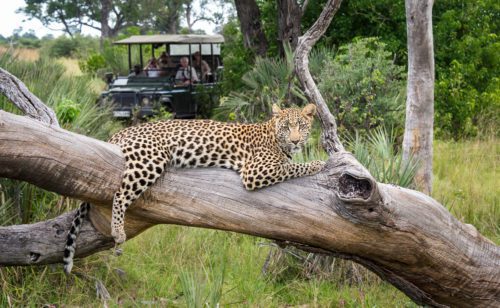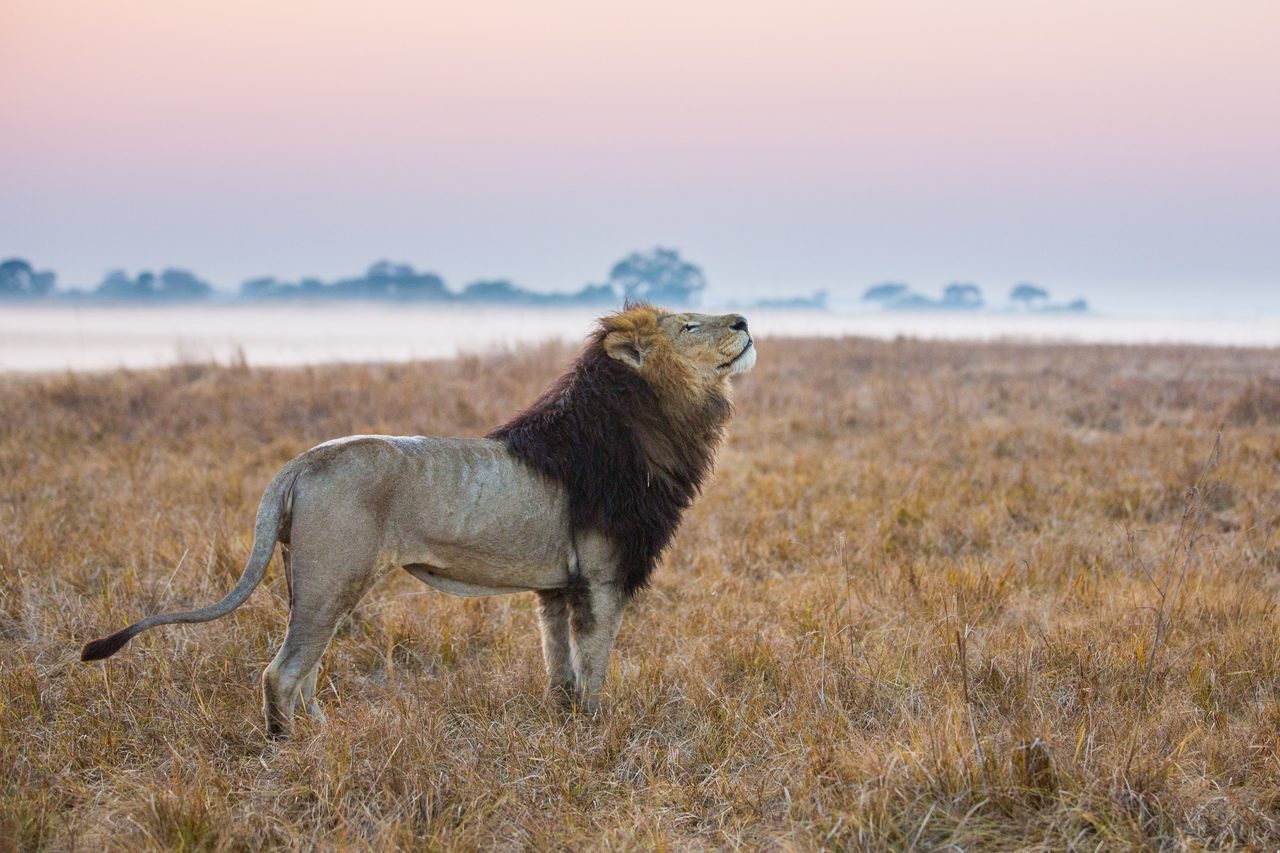Luxury & Private Zambia Safaris
Nowadays, it’s possible to go on safari without sacrificing an ounce of comfort; however, staying in luxury safari camps and lodges with polished marble and enclosed glass walls can sometimes defeat the purpose of immersing yourself in the African bush. For those adventurous travelers who want to go back to the basics of true safari, Zambia is the place.
Large concentrations of wildlife, active adventure, and exclusivity define a Zambia safari. It is the last of the great old-school African safari experiences, successfully combining comfort and service with terrific game viewing in varied and beautiful landscapes.
Zambia is a down-to-earth experience and can include walking safaris, canoeing, and boat safaris alongside crocs and hippos. Adrenaline activities such as whitewater river rafting and bungee jumping are widely available to an intrepid explorer. Zambia is a destination of immense beauty and opportunity—soul food for all who arrive with an open heart.
What to expect on a luxury Zambia safari
Zambia is a paradise for guests wanting to immerse themselves in the wilderness. The wildlife experience is incredible and we recommend it as much for first-time safari-goers as seasoned veterans. Enjoy the sights, sounds, and smells of the wild without the interference of civilization or crowds. You can interact with local owners, trackers, and rangers on a personal basis and get a feel for the real Zambia.
Many travelers are drawn to Livingstone, home of the UNESCO World Heritage Victoria Falls. It offers magnificent views of the Falls and is the spot for adrenaline sports and a host of fun activities.
For those looking for a more active safari experience, Zambia’s system of bushcamps in South Luangwa and North Luangwa means that travelers can walk from camp to camp to fully immerse themselves in the original safari experience. In the Lower Zambezi, water activities like canoeing, boating, and fishing, are great additions to traditional game drives and bush walks.
Zambia FAQs
Best known for its walking safaris, Zambia offers an authentic, back-to-basics safari experience and the opportunity to participate in a number of exciting thrill-seeking activities.
Ten to 12 days is ideal for Zambia. This gives you a few nights in Livingstone to enjoy Victoria Falls, and then two or three nights in a few different camps in places like Lower Zambezi and South Luangwa national parks.
Here are some sample luxury Zambia safari itineraries.
Zambia is a malaria endemic country and visitors are at risk of contracting the mosquito-transmitted disease.
The CDC recommends that travelers going to certain areas of Zambia take prescription medicine to prevent malaria. Consult your doctor to assess which antimalarial is the best option for you.
Visitors to Zambia will get to see crocodiles, hippos, baboons, monkeys, buffalo, lions, elephants, leopards, hyenas, wild dogs and cheetahs as well as many antelope and a variety of birds. (Note: you will not see cheetahs in Lower Zambezi or South Luangwa.)
Travelers hoping for a Big Five sighting should note that rhino were declared extinct in Zambia in 1998.
Thornicroft’s Giraffe and Crawshay’s Zebra are endemic to the area and you may also get to see badgers, civets, porcupines, and genets, plus countless other animal species on a safari in Zambia.
Zambia is paradise for safari-goers wanting to get up close and personal with nature. Enjoy the sights, sounds and smells of the wild without the interference of civilization or crowds. You can interact with local owners, trackers, and rangers on a personal basis and get a feel for the real Zambia.
When considering Zambia as a destination, honestly consider your comfort level for being close to nature. Are you okay with harmless geckos in your tent? Are you excited or scared of the prospect of using a bucket shower on the banks of the Zambezi? Zambia offers life-changing experiences—for the right person.
When is the best time to go on safari in Zambia?
The Zambian dry season stretches from mid-April to mid-November after which many camps become inaccessible. October is great for elephant viewing, but beware that it gets hot. Air conditioning is almost non-existent in many of the camps.
We recommend July to September as a good time to travel because the land is dry and game viewing is good during this peak season.
If you have a sensitive budget, the shoulder season (May/June) offers lower rates and great value for money. The green season, December to April, is terrific for birdlife. Many of the more remote bush camps are closed during these months due to inaccessibility, but there are still plenty of options.
The best whitewater rafting times are straight after the rainy season (March-May) and guests are assured of a longer river run and high water.
Where to go on safari in Zambia
South Luangwa National Park
South Luangwa predominantly features game drives and walking safaris. Starting from a main camp near Mfuwe gate, guests either drive or walk to and between smaller bushcamps (many with only four to six chalets) nestled deeper in the remote parts of the park. Some Zambia safari bush camps have limited road access which is highly appealing to those seeking the purist experience. Other activities do exist at select camps like star beds at Luwi Bush Camp and mountain biking at Tafika Camp. You’ll find some great cultural experiences from the main camps near Mfuwe.
Lower Zambezi National Park
Lower Zambezi National Park is one of Zambia’s most exceptional wildlife areas. Together with Zimbabwe’s Mana Pools National Park on the opposite bank of the river, the area provides a massive trans-frontier wildlife sanctuary. In addition to game drives and walking safaris, safari fun in Lower Zambezi unfolds along the river where you can go tiger fishing, canoeing, or enjoy a gentle sundowner cruise. We believe the best months to visit are July through September. By October it’s often too hot but if you can handle the heat, the game viewing is at it’s absolute peak.
Kafue National Park
Kafue National Park, nestled in the heart of Zambia, is a sprawling wilderness teeming with diverse ecosystems and abundant wildlife. Spanning a land area comparable to the size of Massachusetts, its landscapes range from vast savannahs to dense woodlands, intersected by the meandering Kafue River and its tributaries. Within its borders, visitors can encounter a rich array of wildlife, including elephants, multiple lion prides, leopards, and more than 500 species of birds. The cown jewel of Kafue is undoubtedly the Busanga Plains up in the north, offering an unforgettable safari experience for nature enthusiasts and adventurers alike.
Liuwa Plains
Set in Zambia’s remote western region, Liuwa Plains is a remote landscape characterized by seasonal flooding and abundant wildlife—far from national park crowds. The area is comprised of grassy floodplains, small wooded islands, raffia palm clusters and open pans. Appreciate the golden hour of sunset as the colors change over these sweeping expanses—an indelible part of the magic of Liuwa Plains. In many ways, the landscape is as dynamic as the wildlife that calls this region home.
Livingstone
Livingstone is geared toward active people and adrenaline junkies, but there are activities for any type of traveler. You can bungee jump from a bridge over Victoria Falls, fly over the Falls in a microlight, paddle through Category 5 rapids whitewater rafting down the Zambezi, take a dip in the Devil’s Pool at the edge of Livingstone Island, savor a sundowner boat cruise, savor a fine dining meal aboard a vintage steam train, nibble on high tea at the historic Victoria Falls Hotel or take a helicopter ride over the Falls.
Some of our favorite luxury Zambia safari itineraries

- Itinerary
Back to Nature Wilderness Adventure
Old-School Zambian adventure in owner-run camps

- Itinerary
Exploring Zambia: Walking and Waterways
Explore two of Zambia’s Iconic Parks and Diverse Activities
Some of our favorite luxury safari camps in Zambia
 Lara Ray
Lara Ray














